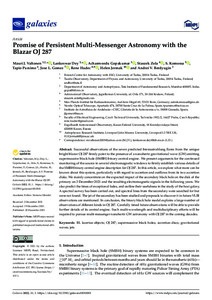Promise of Persistent Multi-Messenger Astronomy with the Blazar OJ 287
Valtonen Mauri J.; Dey Lankeswar; Gopakumar Achamveedu; Zola Staszek; Komossa S.; Pursimo Tapio; Gomez Jose L.; Hudec Rene; Jermak Helen; Berdyugin Andrei V.
Promise of Persistent Multi-Messenger Astronomy with the Blazar OJ 287
Valtonen Mauri J.
Dey Lankeswar
Gopakumar Achamveedu
Zola Staszek
Komossa S.
Pursimo Tapio
Gomez Jose L.
Hudec Rene
Jermak Helen
Berdyugin Andrei V.
MDPI
Julkaisun pysyvä osoite on:
https://urn.fi/URN:NBN:fi-fe2022081154370
https://urn.fi/URN:NBN:fi-fe2022081154370
Tiivistelmä
Successful observations of the seven predicted bremsstrahlung flares from the unique bright blazar OJ 287 firmly point to the presence of a nanohertz gravitational wave (GW) emitting supermassive black hole (SMBH) binary central engine. We present arguments for the continued monitoring of the source in several electromagnetic windows to firmly establish various details of the SMBH binary central engine description for OJ 287. In this article, we explore what more can be known about this system, particularly with regard to accretion and outflows from its two accretion disks. We mainly concentrate on the expected impact of the secondary black hole on the disk of the primary on 3 December 2021 and the resulting electromagnetic signals in the following years. We also predict the times of exceptional fades, and outline their usefulness in the study of the host galaxy. A spectral survey has been carried out, and spectral lines from the secondary were searched for but were not found. The jet of the secondary has been studied and proposals to discover it in future VLBI observations are mentioned. In conclusion, the binary black hole model explains a large number of observations of different kinds in OJ 287. Carefully timed future observations will be able to provide further details of its central engine. Such multi-wavelength and multidisciplinary efforts will be required to pursue multi-messenger nanohertz GW astronomy with OJ 287 in the coming decades.
Kokoelmat
- Rinnakkaistallenteet [27094]
